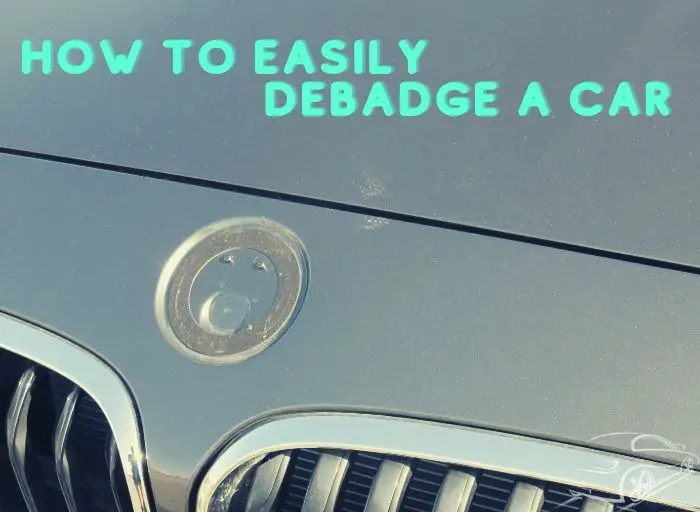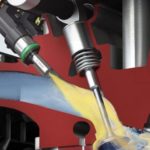
Everyone’s familiar with the issue of how to remove a car tag without damaging the paint. Debadging is an ideal way to get rid of unwanted decals and keep your car looking as good as new. This article provides some tips on how to debadge a car, including techniques used by professionals.
Table of Contents
Understanding Car Badging
Car badging refers to the practice of displaying badges or emblems on the exterior of automobiles. These badges are typically made of metal or plastic and are attached to various parts of the vehicle, such as the hood, trunk, or grille.
They serve as a form of identification, representing the manufacturer, model, trim level, or other distinguishing features of the car.
In addition to manufacturer badges, car badges can also represent specific trims or special editions. Trim badges often indicate different levels of features or options available for a particular model. Special edition badges are used to highlight limited-production models or commemorate significant milestones or events.
Car badges serve multiple purposes. Firstly, they contribute to the vehicle’s overall aesthetics, enhancing its visual appeal. They can also act as a status symbol, representing the prestige associated with a particular brand or model. Moreover, badges provide important information to consumers, helping them identify a car’s make, model, and features at a glance.
Reasons to Debadge a Car
There are several reasons why someone might choose to debadge their car, which means removing the badges or emblems from the exterior of the vehicle. Here are some common reasons for debadging:
Aesthetics
One of the primary reasons people debadge their cars is for aesthetic purposes. By removing the badges, the car’s exterior can appear cleaner and more streamlined. Some individuals prefer the sleek, minimalist look without any visible badges or emblems.
Personalization
Debading a car allows for greater customization and personalization. By removing the manufacturer’s badges, owners can create a unique and customized appearance for their vehicles. This can include adding aftermarket badges, decals, or other personalized touches.
Brand Neutrality
Some car owners prefer to remove badges to avoid promoting or advertising a specific car brand. By debadging, the car becomes more brand-neutral, which can be desirable for individuals who don’t want to associate themselves with a particular brand or want to maintain a more anonymous appearance.
Stealth or Sleeper Look
Debading is often done to create a “stealth” or “sleeper” appearance. This is common among enthusiasts who own high-performance vehicles but prefer not to draw attention to their car’s capabilities. Removing badges can make the car appear more ordinary and inconspicuous on the road.
Resale or Trade-In
In some cases, debadging a car can have practical benefits when it comes to selling or trading in the vehicle. Removing the badges gives the car a more timeless appearance, as model years or trim levels won’t be immediately obvious. This can potentially broaden the appeal to buyers or increase the trade-in value.
How to Debadge a Car Without Damaging the Paint
The high-quality paint and clear coat that comes on your car after the car was painted is guaranteed to protect it against scratches and scuffs. However, if you have a decal that you need to remove, here are some things you must remember:
- Remove the decal from the back of the car.
- Be sure that you first remove any loose debris from around the decal to avoid accidentally scratching or marring your paint during removal.
- If you plan to use the decal ripping tool, make sure that the metal blade is not dull or chipped before attempting to remove the decal. Clean and lubricate the blade for better results.
Warnings Before Debadging a Car
Most car decals are made of thick vinyl, which makes removal difficult. Do not try scrubbing at your decal with a squeegee liner as you may make scratches on your paint or clear coat that cannot be fixed in this process.
Find out: Easy ways to clean your car’s headliners!
Also, do not use ammonia-based cleaners; do not scratch the area you are trying to remove the decal from. It doesn’t matter if your car is a new model or an extra expensive one with a custom paint job; you should still handle it gently.
Debadging Your Car Step-by-Step
#1 Loosen the Adhesive
Badges are attached to the car by either glue or clips. Lucky us that most of the time, manufacturers use glue, which makes our debadging job easier.
You can loosen the glue by using heat. The adhesive behind the badge will be loosened so that you can get behind it. I always use a heat gun for this task instead of a hairdryer, as the heat from the heat gun is stronger and more focused. Therefore, it does the job more effectively.
You need to make sure that all the area under the badge is heated long enough as the glue used is high quality. If you use a hair dryer, you need to spend more time on this task.
If you have a stubborn badge that doesn’t come off with the heat, then apply an adhesive remover to the edge of the logo. I never see this fail.
#2 Removing the Badges
Once the badges have been softened enough, you can remove them using one of these:
- Dental floss
- Fishing wire
- Credit card
- Or a trim-removing tool
I personally prefer using fishing wire as it is thin, flexible, and strong. In contrast, using a credit card or a trim-removing tool poses a risk of scratching the paint.
Use the fishing wire to get under the badge while the glue is still hot. Use slow movement to take the badge off. You will need to remain the badged area in the heat often while doing this.
#3 Cleaning & Waxing
You have done more than half of the work. The badge has come off. Great. Now you see the adhesive residue that needs to be cleaned. A good cleaning product is not found in the market. Therefore, you need to use rubbing alcohol and a soft cloth. Rubbing alcohol will remove the dirt and glue residue, but it will also remove the paint off your car.
I personally use Windex for this job. It does its job effectively without leaving a mark on my car’s paint and clear coat.
After that, you must give the area a good rinse before waxing. A wax layer will protect the area from future damage.
You can check out this video for more detail!
How to Deal with Adhesive Residue After Debaging
Dealing with adhesive residue after debadging a car can be a relatively straightforward process. Here are some steps you can follow to effectively remove the residue:
Gather the necessary materials
You will need a few items to tackle the adhesive residue. Prepare some adhesive remover or solvent (such as rubbing alcohol, Goo Gone, or WD-40), clean microfiber cloths or towels, a plastic scraper or credit card, and warm soapy water.
Step 1: Clean the area: Start by cleaning the debadged area with warm soapy water and a clean cloth. This will remove any surface dirt or debris, allowing you to focus on the adhesive residue.
Step 2: Test the adhesive remover: Before applying the adhesive remover directly to the residue, it’s advisable to test it on a small, inconspicuous area of the car’s surface. This helps ensure that the solvent or remover does not cause any damage or discoloration to the paint or finish.
Step 3:Apply the adhesive remover: Once you have confirmed that the adhesive remover is safe for your car’s surface, apply it to the adhesive residue. You can use a cloth or sponge to gently rub the solvent onto the residue, allowing it to penetrate and loosen the adhesive.
Step 4:Let it soak: After applying the adhesive remover, allow it to soak for a few minutes. This will give the solvent time to dissolve the adhesive, making it easier to remove.
Step 5:Remove the residue: Use a plastic scraper or credit card to carefully scrape off the softened adhesive residue. Be gentle to avoid scratching the paint. If necessary, reapply the adhesive remover and repeat the scraping process until the residue is completely removed.
Step 6:Clean and rinse: Once the adhesive residue is removed, clean the area again with warm soapy water to remove any remaining solvent or residue. Rinse thoroughly and dry the surface with a clean cloth.
Troubleshooting and Tips About Debagging.
When debadging a car, you may encounter some common challenges. Here are a few troubleshooting tips and advice to overcome them:
Stubborn adhesive residue
In some cases, the adhesive residue left behind after removing the badges can be stubborn and difficult to remove. If the adhesive remover or solvent alone doesn’t work, you can try using a clay bar specifically designed for automotive use. Gently rub the clay bar over the residue to lift it off the surface. Alternatively, using a heat gun or hairdryer on a low setting to warm up the adhesive can make it easier to remove.
Damaged paint or finish
If you notice any paint or finish damage during the debadging process, it’s important to address it promptly. Minor scratches or scuffs can often be buffed out with a polishing compound or scratch remover. For deeper damage, you may need to touch up the affected area with matching paint or seek professional assistance from a body shop.
Badge alignment and spacing
When removing multiple badges, ensuring proper alignment and spacing of the remaining badges is essential for a clean and professional look. Before removing any badges, take measurements or photographs to serve as a reference point for reinstallation. Using painter’s tape or a level can help you achieve precise alignment when placing new badges.
Removing badges without damaging them
If you plan to preserve the badges for future use or as collectibles, it’s important to remove them without causing damage. Use a plastic pry tool or fishing line to carefully separate the badge from the adhesive. Gently work your way around the badge, applying even pressure to avoid bending or breaking it.
A few expert tips for a successful debadging process
- Preparation is key: Gather all the necessary tools and materials before starting the debadging process. This includes adhesive removers, clean cloths, plastic scrapers, and other items mentioned earlier. Having everything ready will make the process smoother and more efficient.
- Work in a controlled environment: Perform the debadging process in a shaded area or garage to avoid direct sunlight. Extreme heat can make the adhesive more difficult to remove and may damage the car’s paint. Also, ensure proper ventilation when using adhesive removers or solvents.
- Take your time: Patience is crucial during debadging. Rushing or applying excessive force can lead to paint damage or broken badges. Work slowly and steadily, allowing the adhesive remover to soften the residue adequately.
- Clean and protect: After successfully removing the badges and adhesive residue, thoroughly clean the area and apply a protective wax or sealant. This will help maintain the paint’s integrity and prevent any potential discoloration or damage.
You can also check out this email!!!
Does Debadging a Car Devalue It?
Obviously, the paint will be slightly damaged, but this is not really a big deal because your car is still going to be in good condition. Some people tend to buy a new car once it has been debadged because they think it devalues their old car. While this is probably true for some people, I would say that the great condition of the car does not matter as long as you look good in it.
So, if you want a great-looking car, make sure that you debadge it well. Alternatively, if your current car is in perfect condition but wants a new one to look good, do not bother removing the decal and get a new one. It costs much less than getting a new paint job.
Is Debadging a Car Illegal?
Some states require that you have the manufacturer’s name or logo on the exterior of your car. Therefore, you need to debadge as soon as you get a new car. The way of this removal process will not damage the paint, and it is perfectly legal.
However, some states do not require this kind of information on your car. Or, they only allow it to be in certain areas like on the rear window. In these places, removing an exterior decal would be illegal as a violation of your state’s laws and regulations.
To ensure compliance with the law when debadging your car, consider the following tips:
- Research local regulations: Familiarize yourself with the specific regulations governing vehicle modifications in your area. Consult official government websites or seek advice from local automotive authorities or law enforcement agencies.
- Maintain legal and safety requirements: Ensure that the removal of badges does not compromise the vehicle’s legal and safety requirements. Specific badges, such as VIN plates or emission labels, may be required by law to be displayed on the vehicle.
- Preserve originality: If you choose to remove badges, do so in a way that allows you to reattach them later if needed, especially if they contain essential information or comply with legal requirements. Keep the removed badges and any related documentation to demonstrate compliance if necessary.
Why Do Some People Debadge Their Vehicles?
#1 Avoiding Advertising
Another great reason to debadge is to avoid advertising yourself or your company. It’s as simple as that. If you’re in the sales industry or an industry where you have to attract new customers, you may want your car to remain a mystery until you’ve managed to sell the car.
#2 Blending In When Driving A Sleeper Vehicle
Some people like to keep their vehicle in top shape for use in racing or as a “sleeper.” In other words, to keep the vehicle from looking fast, you need to debadge it.
#3 Being Unique And Customizing The Car To Their Taste
Is this not the main reason why people buy a car? For me, I always try to customize my car if I can. I want it to look different from all the other cars out there. I don’t like the logo of the car manufacturer on my car. I love the factory looks of cars. That is why I remove all the decals from my car and replace them with vinyl stickers and a custom paint job.
Frequently Asked Questions
#1 Is debadging a car legal?
The legality of debadging a car depends on the specific regulations in your jurisdiction. Research and understand the local laws before proceeding.
#2 Can I debadge my leased vehicle?
Debading a leased vehicle may not be allowed, as lease agreements often have restrictions on modifying the vehicle’s appearance. Check your lease agreement or consult with the leasing company for clarification.
#3 Will debadging affect my car’s warranty?
Debading a car typically does not affect the manufacturer’s warranty unless damage occurs during the process. However, it’s recommended to consult your car’s warranty documentation or contact the manufacturer for specific information.
#4 How long does the debadging process take?
The duration of the debadging process can vary depending on factors such as the number and type of badges, adhesive strength, and your experience. It can range from a few minutes to a couple of hours.
#5 Can I remove the badge without leaving any adhesive residue?
It’s challenging to remove badges without leaving any adhesive residue. Using adhesive removers or solvents, along with proper techniques and tools, can minimize residue, but some residue may still remain.
#6 Can I replace the badges with custom emblems?
You can often replace the badges with custom emblems if desired. There are aftermarket options available that allow you to personalize the appearance of your car while still complying with legal requirements. Ensure that any custom emblems comply with local regulations and are properly installed.
Final Words
To conclude, it is your decision whether to remove the decal or not. Understand that some car manufacturers like to include their logos on their vehicles in order to advertise themselves. Removing these decals will not devalue your vehicle. Likewise, just because the manufacturer might require that you have this information on your car, it does not mean that removing them from your vehicle will devalue it.
So, make sure to research the laws in your state regarding exterior decals before attempting the removal of any kinds of stickers and logos from your or another’s car.
Hi everyone, My name is Ollie Barker.
As a seasoned auto expert I have 25 years of experience working in repair and detailing shops. I love to share my tips & tricks to all car lovers, so that’s why I’m here at Automotive Gearz publishing my content, sharing my passion. Also, I’ve been giving my recommendations on which products are the best to have on the market. I always thought it was hard to pick the right part, so hopefully I can make that a bit easier for you.
Hope you enjoy your time on my little blog!







